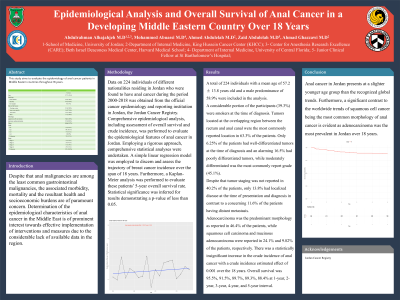Tuesday Poster Session
Category: Colon
P3006 - Epidemiological Analysis and Overall Survival of Anal Cancer in a Developing Middle Eastern Country Over 18 Years
Tuesday, October 24, 2023
10:30 AM - 4:00 PM PT
Location: Exhibit Hall

Has Audio

Mohammad AbuAssi, MD
University of Central Florida College of Medicine
Gainesville, FL
Presenting Author(s)
Abdulrahman Alhajahjeh, 1, Zaid A. Abdulelah, MD2, Ahmed A. Abdulelah, MD3, Ahmad Ghazzawi, MD3, Mohammad Abuassi, MD4, Amer Khatib, MD3
1University of Jordan School of Medicine, Amman, 'Amman, Jordan; 2St Bartholomew's Hospital, London, England, United Kingdom; 3School of Medicine, The University of Jordan, Amman, 'Amman, Jordan; 4University of Central Florida College of Medicine, Gainesville, FL
Introduction: Despite that anal malignancies are among the least common gastrointestinal malignancies, the associated morbidity, mortality and the resultant health and socioeconomic burdens are of paramount concern. Determination of the epidemiological characteristics of anal cancer in the Middle East is of prominent interest towards effective implementation of interventions and measures due to the considerable lack of available data in the region.
Methods: Data on 224 individuals of different nationalities residing in Jordan who were found to have anal cancer during the period 2000-2018 was obtained from the official cancer epidemiology and reporting institution in Jordan, the Jordan Cancer Registry. Comprehensive epidemiological analysis, including assessment of overall survival and crude incidence, was performed to evaluate the epidemiological features of anal cancer in Jordan.
Results: A total of 224 individuals with a mean age of 57.2 ± 13.8 years old and a male predominance of 58.9% were included in the analysis. A considerable portion of the participants (39.3%) were smokers at the time of diagnosis. Tumors located at the overlapping region between the rectum and anal canal was the most commonly reported location in 50% of the patients. Only 6.25% of the patients had well differentiated tumors at the time of diagnosis and an alarming 16.5% had poorly differentiated tumors, while moderately differentiated was the most commonly report grade (45.1%). Despite that tumor staging was not reported in 40.2% of the patients, only 13.8% had localized disease at the time of presentation and diagnosis in contrast to a concerning 11.6% of the patients having distant metastasis. Adenocarcinoma was the predominant morphology as reported in 46.4% of the patients, while squamous cell carcinoma and mucinous adenocarcinoma were reported in 24.1% and 9.82% of the patients, respectively. There was a statistically insignificant increase in the crude incidence of anal cancer with a crude incidence estimated effect of 0.001 over the 18 years. The overall survival was 95.5%, 91.5%, 89.7%, 89.3%, and 88.4% at 1-year, 2-year, 3-year, 4-year, and 5-year interval.
Discussion: Anal cancer in Jordan presents at a slighter younger age group than the recognized global trends. Furthermore, significant contrasting to the worldwide trends of squamous cell cancer being the most common morphology of anal cancer is evident as adenocarcinoma was the most prevalent in Jordan over 18 years.
Disclosures:
Abdulrahman Alhajahjeh, 1, Zaid A. Abdulelah, MD2, Ahmed A. Abdulelah, MD3, Ahmad Ghazzawi, MD3, Mohammad Abuassi, MD4, Amer Khatib, MD3. P3006 - Epidemiological Analysis and Overall Survival of Anal Cancer in a Developing Middle Eastern Country Over 18 Years, ACG 2023 Annual Scientific Meeting Abstracts. Vancouver, BC, Canada: American College of Gastroenterology.
1University of Jordan School of Medicine, Amman, 'Amman, Jordan; 2St Bartholomew's Hospital, London, England, United Kingdom; 3School of Medicine, The University of Jordan, Amman, 'Amman, Jordan; 4University of Central Florida College of Medicine, Gainesville, FL
Introduction: Despite that anal malignancies are among the least common gastrointestinal malignancies, the associated morbidity, mortality and the resultant health and socioeconomic burdens are of paramount concern. Determination of the epidemiological characteristics of anal cancer in the Middle East is of prominent interest towards effective implementation of interventions and measures due to the considerable lack of available data in the region.
Methods: Data on 224 individuals of different nationalities residing in Jordan who were found to have anal cancer during the period 2000-2018 was obtained from the official cancer epidemiology and reporting institution in Jordan, the Jordan Cancer Registry. Comprehensive epidemiological analysis, including assessment of overall survival and crude incidence, was performed to evaluate the epidemiological features of anal cancer in Jordan.
Results: A total of 224 individuals with a mean age of 57.2 ± 13.8 years old and a male predominance of 58.9% were included in the analysis. A considerable portion of the participants (39.3%) were smokers at the time of diagnosis. Tumors located at the overlapping region between the rectum and anal canal was the most commonly reported location in 50% of the patients. Only 6.25% of the patients had well differentiated tumors at the time of diagnosis and an alarming 16.5% had poorly differentiated tumors, while moderately differentiated was the most commonly report grade (45.1%). Despite that tumor staging was not reported in 40.2% of the patients, only 13.8% had localized disease at the time of presentation and diagnosis in contrast to a concerning 11.6% of the patients having distant metastasis. Adenocarcinoma was the predominant morphology as reported in 46.4% of the patients, while squamous cell carcinoma and mucinous adenocarcinoma were reported in 24.1% and 9.82% of the patients, respectively. There was a statistically insignificant increase in the crude incidence of anal cancer with a crude incidence estimated effect of 0.001 over the 18 years. The overall survival was 95.5%, 91.5%, 89.7%, 89.3%, and 88.4% at 1-year, 2-year, 3-year, 4-year, and 5-year interval.
Discussion: Anal cancer in Jordan presents at a slighter younger age group than the recognized global trends. Furthermore, significant contrasting to the worldwide trends of squamous cell cancer being the most common morphology of anal cancer is evident as adenocarcinoma was the most prevalent in Jordan over 18 years.
Disclosures:
Abdulrahman Alhajahjeh indicated no relevant financial relationships.
Zaid A. Abdulelah indicated no relevant financial relationships.
Ahmed A. Abdulelah indicated no relevant financial relationships.
Ahmad Ghazzawi indicated no relevant financial relationships.
Mohammad Abuassi indicated no relevant financial relationships.
Amer Khatib indicated no relevant financial relationships.
Abdulrahman Alhajahjeh, 1, Zaid A. Abdulelah, MD2, Ahmed A. Abdulelah, MD3, Ahmad Ghazzawi, MD3, Mohammad Abuassi, MD4, Amer Khatib, MD3. P3006 - Epidemiological Analysis and Overall Survival of Anal Cancer in a Developing Middle Eastern Country Over 18 Years, ACG 2023 Annual Scientific Meeting Abstracts. Vancouver, BC, Canada: American College of Gastroenterology.
